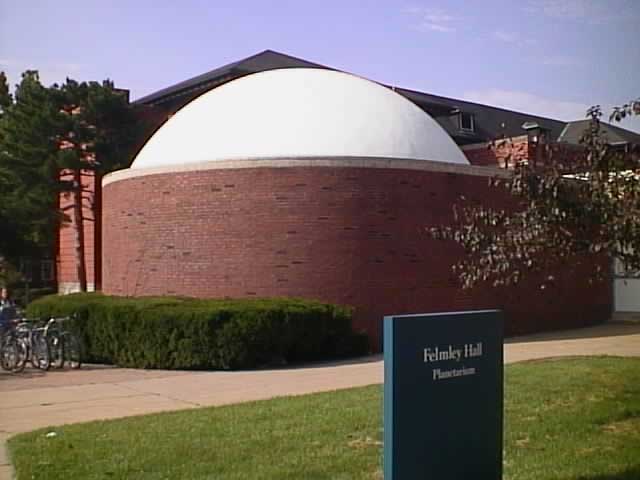Have you ever walked near Felmey Hall on School Street and wondered about the white dome? The 30-foot diameter dome is in the annex to Felmley Hall and is the home of the 110-seat Illinois State University Planetarium. The planetarium officially opened, without fanfare, on September 1, 1964. Around 1960, Bernie Ryder, chair of the Natural Sciences Department, requested funding for an expansion of the Felmley Hall of Science. In 1962 the University received a grant from the National Science Foundation to assist with a $1.8 million annex to Felmley Hall.
As the project was nearing completion, the project was clearly under budget. Not wanting to waste appropriated money, a planetarium was added only as an afterthought when the National Science Foundation (NSF) program funding the expansion project first requested and then reviewed a wish list from the science department. The wish list was prepared by Ryder and physicist Harold Born. At the very bottom of this 30-item wish list was a planetarium. The NSF program officers reviewed this aspect of the wish list favorably, and a planetarium was added with little concern for mission, staffing, parking, and restroom facilities. The annex, including the planetarium, was officially opened on September 1, 1964. It was later agreed that the planetarium should serve the purpose of being used in the science department’s astronomy course, for holding adult education courses, for instructing school and social groups, and for admitting the general public from time to time.
The planetarium opened without a formal staff. Physics Professor Harold Born asked Illinois Wesleyan University astronomer Ray Wilson to help with getting the new planetarium operational. That September, Wilson gave several local astronomy club members a peek at the new facility, and explained how the Spitz A3-P star machine projected sun, moon, and planets, along with 1,354 stars, their coordinate systems, and the Milky Way.
Wilson subsequently was asked to “give a show” to the rest of the astronomy club. He did this on October 1, 1964, one month after the official building opening. Thus began the long and cordial relationship between the planetarium and the Twin City Amateur Astronomers that continued for many years under the guidance of various Illinois State Physics faculty members who gave monthly planetarium programs for the general public (1964–1971). After the Physics Department was established in 1966, the planetarium fell under its auspices. It then became known as the Illinois State University Physics Department Planetarium.
Starting in 1970 Nerio Calgaro served as de facto part-time planetarium director while still a physics major at the University. He was hired officially as the planetarium’s first director and served in this capacity from 1971 through 1974. Patrick McGee, a bona fide planetarium director with a Master of Arts in Teaching degree from Michigan State University in planetarium education served as director from 1974 through 1978. Carl J. Wenning, also with an M.A.T. degree in planetarium education from Michigan State served in this capacity from August 21, 1978, to June 30, 2001. Thomas Willmitch, an experienced planetarium director was hired on November 1, 2000, to assist Wenning whose duties were split between the planetarium and serving as coordinator of the Physics Department’s growing physics teacher education program. Willmitch became the next planetarium director following Wenning’s official departure as director. Willmitch was officially named planetarium director on July 1, 2001, and he continues in this capacity to the present.
Today, the planetarium serves around 20,000 attendees per year, including those from school groups, teacher workshops, community groups, and adult education classes. The original projector is still working, though it was modified in 1986 and has had a lot of maintenance. It can now project 2,354 stars, along with additional effects, such as binary stars, eclipses, star clusters, and more. In addition to live performances, taped performances are available in six foreign languages. For more information, please visit the planetarium website.


The byline should also list Carl J. Wenning, who wrote the history of the planetarium from which this story is drawn.
Yeah, how informative!